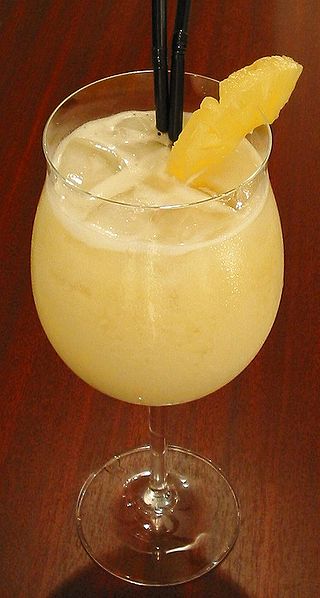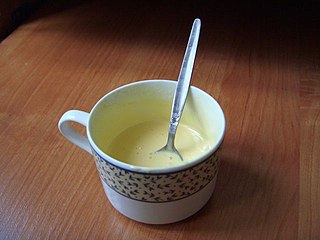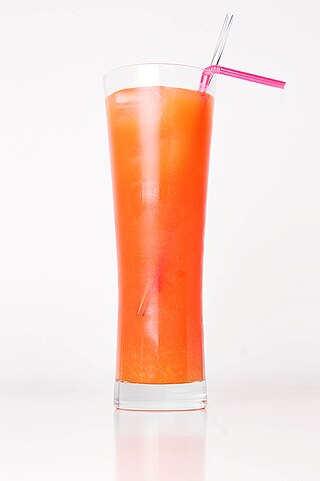
The Piña Colada is a cocktail made with rum, cream of coconut, and pineapple juice, usually served either blended or shaken with ice. It may be garnished with either a pineapple wedge, maraschino cherry, or both. The drink originated in Puerto Rico.

A margarita is a cocktail consisting of tequila, triple sec, and lime juice. Some margarita recipes include simple syrup as well and are often served with salt on the rim of the glass. Margaritas can be served either shaken with ice, without ice, or blended with ice. Most bars serve margaritas in a stepped-diameter variant of a cocktail glass or champagne coupe called a margarita glass. The margarita is one of the world's most popular cocktails and the most popular tequila-based cocktail.

The martini is a cocktail made with gin and vermouth, and garnished with an olive, a lemon twist, or both. Over the years, the martini has become one of the best-known mixed alcoholic beverages. A common variation, the vodka martini, uses vodka instead of gin for the cocktail's base spirit.

Amaretto is a sweet Italian liqueur originating from the comune (municipality) of Saronno. Depending on the brand, it may be made from apricot kernels, bitter almonds, peach stones, or almonds, all of which are natural sources of the benzaldehyde that provides the almond-like flavour of the liqueur. It generally contains 21 to 28 percent alcohol by volume.

Fruit salad is a dish consisting of various kinds of fruit, sometimes served in a liquid, either their juices or a syrup. In different forms, fruit salad can be served as an appetizer or a side as a salad. A fruit salad is sometimes known as a fruit cocktail, or fruit cup.

An ice cream float or ice cream soda, also known as an ice cream spider in Australia and New Zealand, is a chilled beverage made by adding ice cream to a soft drink or to a mixture of flavored syrup and carbonated water.
Vermeer Dutch Chocolate Cream Liqueur is a sweet liqueur made of Dutch chocolate, cream, and vodka. It was created by Maurice Kanbar who tested it for five years before presenting the liqueur to the public in 2001. Vermeer is 34 U.S. proof and the bottles are labeled with an image of Johannes Vermeer's Girl with a Pearl Earring.

The gimlet is a cocktail made of gin and lime cordial. A 1928 description of the drink was: gin, and a spot of lime. A description in the 1953 Raymond Chandler novel The Long Goodbye stated that "a real gimlet is half gin and half Rose's lime juice and nothing else." This is in line with the proportions suggested by The Savoy Cocktail Book (1930), which specifies one half gin and one half lime juice. However, some modern tastes are less sweet, and generally provide for up to four parts gin to one part lime cordial.

Batida is a Brazilian cocktail, and is one of several Brazilian cocktails that are made with the national alcoholic drink cachaça. In Portuguese batida means shaken or milkshake, and the word also means a crash, usually used when referring to a car crash. This beverage is made with cachaça, fruit juice, and sugar. It is blended or shaken with ice.

"Shaken, not stirred" is how Ian Fleming's fictional British Secret Service agent James Bond prefers his martini cocktail.

Kogel mogel is an egg-based homemade dessert once popular in parts of Europe. It is made from egg yolks, sugar, and flavourings such as honey, vanilla, cocoa or rum, similar to eggnog or zabaione. In its classic form it is served slightly chilled or at room temperature. Served warm or hot, it is considered a home remedy for sore throats. Variations include milk, honey and soda.

A shooter, or shot, is a small serving of spirits or a mixed drink, typically consumed quickly, often in a single gulp. It is common to serve a shooter as a side to a larger drink.

A Grasshopper is a sweet, mint-flavored, after-dinner alcoholic drink named for its green color, which comes from crème de menthe. Tujague's, a bar in the French Quarter of New Orleans, Louisiana, claims its owner Philip Guichet invented the drink in 1918. The drink gained popularity during the 1950s and 1960s throughout the American South.

A "fizz" is a mixed drink variation on the older sours family of cocktail. Its defining features are an acidic juice and carbonated water. It typically includes gin or rum as its alcoholic ingredient.

There are many cocktails made with cachaça, the national spirit of Brazil. The caipirinha is by far the most popular and internationally well-known, but bartenders have developed other mixed drinks using the spirit.

A sex on the beach is an alcoholic cocktail containing vodka, peach schnapps, orange juice and cranberry juice. It is an International Bartenders Association Official Cocktail.

The pink lady is a classic gin-based cocktail with a long history. Its pink color comes from grenadine.
The Blue bird is a gin or vodka cocktail with blue curacao. The Savoy Cocktail Book gives the recipe as gin with Angostura bitters and curacao. Another recipe from the Café Royal Cocktail Book (1937) uses vodka instead of gin, adding maraschino liquor, and fresh lemon juice. The original gin-based cocktail was reimagined by Bill Tarling, who was known for various blue colored cocktails. The earlier recipe used angostura bitters which would have effected the final color of the cocktail, and may be the reason behind Tarling's changes to the original recipe.
















